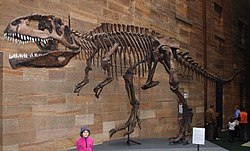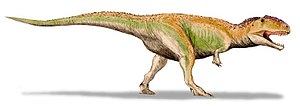Giganotosaurus: Difference between revisions
| Line 27: | Line 27: | ||
''Giganotosaurus carolinii'' was named for Ruben Carolini, an amateur fossil hunter, who discovered the fossils in the deposits of the Rio Limay Formation of [[Patagonia]], southern [[Argentina]], in 1993. It was published by Rodolfo Coria and Leonardo Salgado in the journal ''[[Nature (journal)|Nature]]'' in 1995<ref>Coria RA & Salgado L (1995). A new giant carnivorous dinosaur from the [[Cretaceous]] of [[Patagonia]]. ''Nature'' 377: 225-226</ref>. |
''Giganotosaurus carolinii'' was named for Ruben Carolini, an amateur fossil hunter, who discovered the fossils in the deposits of the Rio Limay Formation of [[Patagonia]], southern [[Argentina]], in 1993. It was published by Rodolfo Coria and Leonardo Salgado in the journal ''[[Nature (journal)|Nature]]'' in 1995<ref>Coria RA & Salgado L (1995). A new giant carnivorous dinosaur from the [[Cretaceous]] of [[Patagonia]]. ''Nature'' 377: 225-226</ref>. |
||
The [[holotype]] specimen's (MUCPv-Ch1) skeleton was about 70% complete and included the [[skull]], [[pelvis]], [[femur|leg bone]]s and most of the [[vertebra|backbone]]. A second specimen (MUCPv-95), 8% larger, has also been recovered. The largest ''Giganotosaurus'' is estimated to be [[1 E1 m|13.7 m]] (45 [[foot|ft]]) long |
The [[holotype]] specimen's (MUCPv-Ch1) skeleton was about 70% complete and included the [[skull]], [[pelvis]], [[femur|leg bone]]s and most of the [[vertebra|backbone]]. A second specimen (MUCPv-95), 8% larger, has also been recovered. The largest ''Giganotosaurus'' is estimated to be [[1 E1 m|13.7 m]] (45 [[foot|ft]]) long, and weighed 5.2 [[short ton|ton]]s. The specimen's skull was the size of a bathtub, measuring 1.95 m (6 ft 5 in). ''Giganotosaurus'' surpasses ''[[Tyrannosaurus rex]]'' in length by almost 2 m. [http://dml.cmnh.org/2003Jul/msg00355.html]. |
||
''Giganotosaurus'' species |
''Giganotosaurus'' species |
||
Revision as of 17:59, 14 January 2007
| Giganotosaurus Temporal range: mid Cretaceous
| |
|---|---|
| File:Dinosaur1-420x315.jpg | |
| Skull of Giganotosaurus | |
| Scientific classification | |
| Kingdom: | |
| Phylum: | |
| Class: | |
| Superorder: | |
| Order: | |
| Suborder: | |
| Infraorder: | |
| Superfamily: | |
| Family: | |
| Subfamily: | |
| Genus: | Giganotosaurus
|
| Binomial name | |
| Giganotosaurus carolinii | |
Giganotosaurus (meaning 'giant southern lizard', derived from the Ancient Greek gigas/γιγας meaning 'giant', notos/νοτος meaning 'south wind' and saurus/σαυρος meaning 'lizard'[1]) was a carcharodontosaurid dinosaur that lived 93 to 89 million years ago during the Turonian stage of the Late Cretaceous Period. It is one of the largest known terrestrial carnivores, longer than Tyrannosaurus, but smaller than Spinosaurus.
Discovery and species

Giganotosaurus carolinii was named for Ruben Carolini, an amateur fossil hunter, who discovered the fossils in the deposits of the Rio Limay Formation of Patagonia, southern Argentina, in 1993. It was published by Rodolfo Coria and Leonardo Salgado in the journal Nature in 1995[2].
The holotype specimen's (MUCPv-Ch1) skeleton was about 70% complete and included the skull, pelvis, leg bones and most of the backbone. A second specimen (MUCPv-95), 8% larger, has also been recovered. The largest Giganotosaurus is estimated to be 13.7 m (45 ft) long, and weighed 5.2 tons. The specimen's skull was the size of a bathtub, measuring 1.95 m (6 ft 5 in). Giganotosaurus surpasses Tyrannosaurus rex in length by almost 2 m. [1].
Giganotosaurus species
- Giganotosaurus . carolinii
Paleobiology

G. carolinii was larger than T. rex but had a much smaller brain that was the size and shape of a banana. A well-developed olfactory region means it probably had a good sense of smell.
Titanosaur fossils have been recovered near the remains of Giganotosaurus, leading to speculation that these carnivores may have preyed on the giant herbivores. Fossils of related carcharodontosaurid fossils grouped closely together may indicate pack hunting, a behavior that could possibly extend to Giganotosaurus itself.
Classification
Giganotosaurus, along with relatives like Tyrannotitan, Mapusaurus and Carcharodontosaurus, are members of the carnosaur family Carcharodontosauridae. It and Mapusaurus have been placed in their own subfamily Giganotosaurinae by Coria and Currie in 2006 as more Carcharodontosaurid dinosaurs are found and described, allowing interrelationships to be calculated[3].
Popular Culture
The original fossils of Giganotosaurus remain at the Carmen Funes Museum in Neuquen, Argentina, but replicas are common in other places, including the Australian Museum in Sydney.
For such a newly discovered dinosaur, Giganotosaurus is already gaining a name for itself in popular culture:
- The Giganotosaurus also appears in the Walking with Dinosaurs special Land of Giants. They are seen to hunt both independently and in packs, working together to bring down an Argentinosaurus.
- One of the alternate modes of the Transformers character Magmatron is a Giganotosaurus. The others are an Elasmosaurus and a Pteranodon.
- The Zoids mecha Gojulas Giga is a Giganotosaurus type.
- The PlayStation game Dino Crisis 2 features a Giganotosaurus. However, the size of the Giganotosaurus in the game was exaggerated and is much larger than in real life. In the game it is portrayed as being over 20 meters long and over 7 meters tall, while in real life it was, at most, 14 meters long and 5.5 meters tall.
- Giganotosaurus appears in the Playstation game Warpath: Jurassic Park as a playable character.
- Giganotosaurus also makes an appearance in the first person shooter PC game Carnivores 4: CityScape and can either be an enemy for the player taking the role of the Agent or can be played as if the player takes the role of Dino.
References
- ^ Liddell & Scott (1980). Greek-English Lexicon, Abridged Edition. Oxford University Press, Oxford, UK. ISBN 0-19-910207-4.
- ^ Coria RA & Salgado L (1995). A new giant carnivorous dinosaur from the Cretaceous of Patagonia. Nature 377: 225-226
- ^ Coria RA & Currie PJ. (2006): A new carcharodontosaurid (Dinosauria, Theropoda) from the Upper Cretaceous of Argentina. Geodiversitas: Vol. 28, #1, pp. 71-118
External links
- "Giganotosaurus carolinii". DinoData.
- "What were the longest/heaviest predatory dinosaurs?". Mike Taylor. The Dinosaur FAQ. August 27, 2002.
